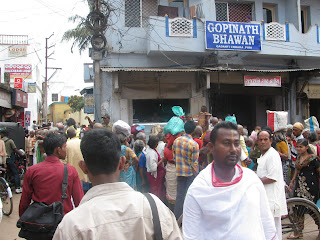We departed for Goa early in the morning and had a 2 hour layover in Hyderabad, accompanied by some excellent biryani and beer and then arrived in Goa at 4 in the afternoon. It was very interesting while we were telling everyone that we were planning on going to Goa and that I was so excited I was finally going to get tan that there was probably not going to be any sunshine due to the monsoon. Lets just say I felt like a fool packing my sun tan lotion.
After a 40 km taxi ride that cost about $10 we arrived at Alcove resort on Little Vagator beach. For anyone who ever travels to Goa I highly recommend this place. They gave us 2 rooms for 2,000 rupees per night and had some of the best food and service I have ever experienced. I will say the only downside was that during the monsoon most of the bars and restaurants around the resort were closed for the season which left us with very little choice in the surrounding areas.
The view from our doorstep, the Arabian Sea in the distance
For the rest of the evening we just relaxed at the restaurant (the hut with the translucent blue wall). That night we had also inquired as to whether we could rent scooters and they told us they would be available for the entire day at 600 rupees a piece. I am sure Ben had a good laugh the next morning when Katrina and I were trying to figure out how to balance on the scootys (scooters that you do not have to shift) and not run them into a wall. When we finally got the hang of it we very gingerly drove into town with Anjuna Beach being our final destination.
Our chariots
I was so surprised how easy it was to rent the scootys. We did not even have to show our drivers licenses, they did not ask us if we had driven them before nor did they require that we put now a security deposit. Whenever you rent something in the US it feels like you have to sign your life away and pay so much more than whatever you are renting is even worth.
The drive through Goa was so beautiful I felt as if I was driving through a rain forest. The traffic was so much less hectic than anywhere else I have been in India and every road was lined with banyan and palm trees. We also really lucked out with the weather, evidently it had been pouring for a week straight before we came and it seemed like someone turned off a faucet that morning. It only rained once it was only for 3 or so minutes and luckily we had already reached Anjuna beach at that point.
Anjuna Beach and the Arabian Sea
We walked along the beach for a little while and then went to this restaurant that had some of the best food I have had thus far. I was extremely surprised though when I opened the menu and saw that beef was an option. This particular area along with the area surrounding Mumbai had been colonized by the Portuguese and the people there are predominantly Christian. We were still a little leery of the option to eat beef and instead opted for some of their amazing seafood. We ordered prawns, calamari, and three different types of crab that were equally amazing, and for the price of $20 extremely gluttonous.
Ben after the damage was done
After we finished lunch we scooted around for a while before finding a quiet beach where people would not take a thousand pictures of us so we could go swimming. I could not believe how strong the riptide was in the Arabian Sea. It took all of our strength not to be swept away and the water was fairly muddy which was also a result of the monsoon rains. After being sufficiently exhausted we returned back to the resort for dinner and a night cap.
The next morning it was raining a little bit more but only in spurts so we decided to rent to scootys again. We had breakfast/lunch at this awesome Mexican themed restaurant that had amazing French Onion soup and phenomenal rice and tortillas. I still cannot get over how beautiful Goa is even when it is pouring and gray. The canal systems are reminiscent of Amsterdam with the exception that they are surrounded by rice paddies and palm trees instead of brick buildings and the red light district
Indian Riviera
One of the canals
After we left the restaurant we headed down to Fort Aguada which was built in the 17th century by the Portuguese and is still pretty well intact today. I was really surprised that we did not have to pay to get into the fort and also that there were virtually no railings to stop you from falling in. Furthermore the lack of security was incredible. There was a group of young guys that I was pretty sure were quite intoxicated crawling all over the place and balancing on the top of the barricades.
Fort Aguada
View from the fort, there was a ship that looked like it had been beached there for a fairly long time
The fort's lighthouse
Moat around the fort






 F
F





 S
S


 J
J A
A O
O






 U
U


 A
A









